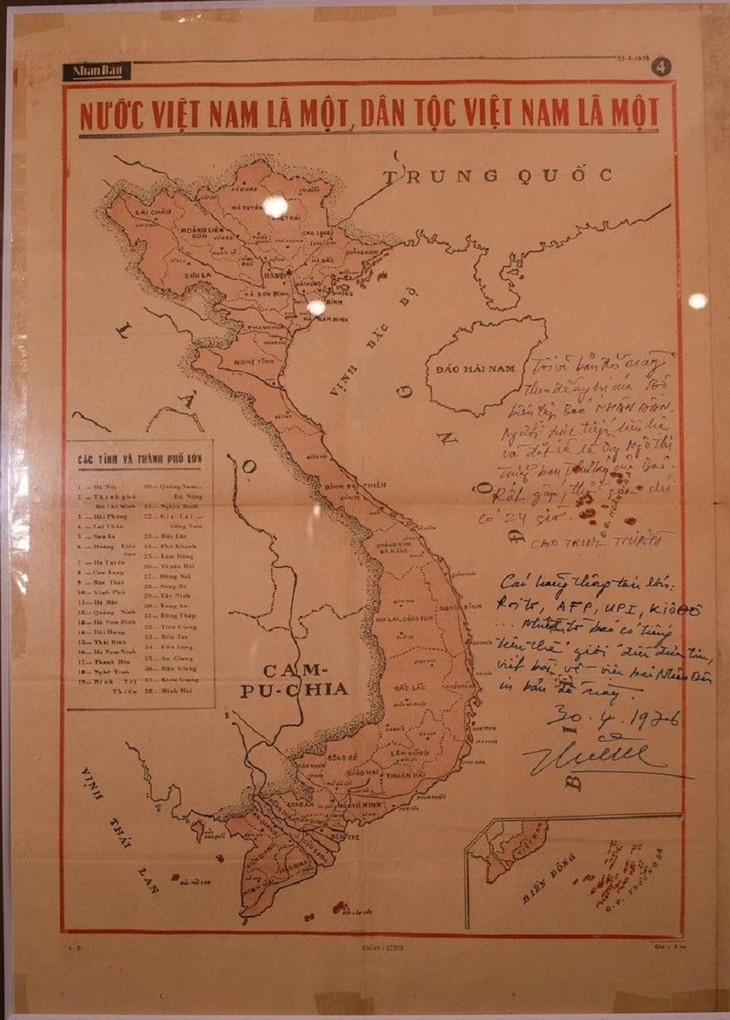 The map of unified Vietnam in 1976 printed in the special issue of Nhan Dan (People) newspaper. (Source: Nhan Dan newspaper) The map of unified Vietnam in 1976 printed in the special issue of Nhan Dan (People) newspaper. (Source: Nhan Dan newspaper) |
Map of Unified Vietnam
In early April, in a small house on Tho Lao street, Hanoi, we met painter Cao Trong Thiem, who turned 80 years old this year. In 1976 he drew a map of unified Vietnam, which was printed in a special issue of the Nhan Dan (People) newspaper to serve the first general election following liberation.
Thiem walked over to a cabinet in the corner of the room and took out a vintage newspaper with a map of unified Vietnam.
Over a cup of tea, the painter and his wife opened the newspaper, which was published nearly half a century ago, and looked once again at a red map decorated with the words “Vietnam is one, the Vietnamese people are one”.
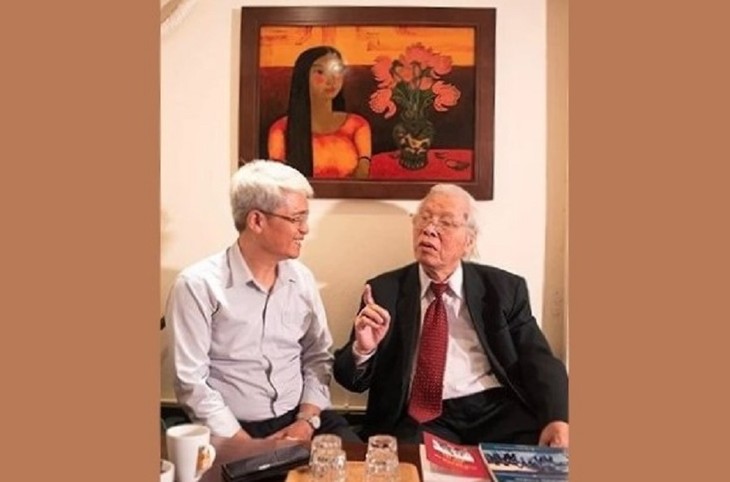 Painter Cao Trong Thiem (right) talks with journalist Ha Hong (Source: Nhan Dan newspaper) Painter Cao Trong Thiem (right) talks with journalist Ha Hong (Source: Nhan Dan newspaper) |
Thiem recalled: “There were already many maps, so why did Nhan Dan newspaper ask me to draw a new map for its special issue? Its intention was to affirm as official Vietnam's boundaries and sovereignty.”
Though surprised by the newspaper’s request, Thiem was very excited. He used his pen to draw small dotted lines, reminding himself to make the map simple and easy to see and to highlight the theme “Vietnam is one, the Vietnamese people are one”.
“I had just 24 hours to complete it. I had to draw all day and all night to get it done on time. I felt very motivated because the task was so important, it had to show that the Vietnamese people are one, that Vietnam is one. We had to fight and sacrifice, and many laid down their lives, for what we have today,” said Thiem.
Thiem depicted each place on the map neatly. The borders were clearly drawn. And the Truong Sa (Spratly), Hoang Sa (Paracel) and Tho Chu islands were highlighted to affirm Vietnam’s sovereignty over them.
Thiem told VOV: “When I drew this map, I showed clearly that Vietnam is a unified nation, a nation with full sovereignty. The people of every region are Vietnamese. On the map there are 38 provinces and cities. The national land and sea borders are highlighted for easy recognition, especially the Hoang Sa and Truong Sa archipelagos and Tho Chu island.”
The newspaper with the map of Vietnam has been carefully preserved for 50 years by Thiem and his family as a tribute to the soldiers and other compatriots who laid down their lives for national peace and reunification.
Vietnam is one, the Vietnamese people are one
The map of a unified Vietnam by painter Cao Trong Thiem and many other painters was made possible thanks to the sacrifices and bravery of millions of Vietnamese from the North to the South, from the Central Highland forests to the coastal plains during 21 years of protracted resistance from 1954 to 1975. Some of the martyrs are buried in marked graves, but the bodies of millions more have become part of the soil of Vietnam.
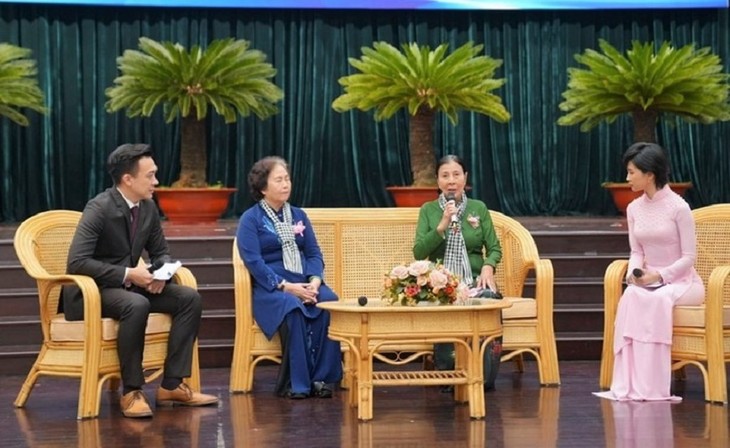 Ms. Tran Thi Hoa (second from right) at a meeting with outstanding female former revolutionary prisoners organized by the Vietnam Women's Union and the Ho Chi Minh City Party Committee on February 28, 2025. (Photo: hoilhpn.org.vn) Ms. Tran Thi Hoa (second from right) at a meeting with outstanding female former revolutionary prisoners organized by the Vietnam Women's Union and the Ho Chi Minh City Party Committee on February 28, 2025. (Photo: hoilhpn.org.vn) |
Mrs. Tran Thi Hoa , a resident of Dong Nai province, was one of thousands of women imprisoned and tortured in prisons in Con Dao, Phu Quoc and Phu Tai, where the compatriots shared with each other every grain of salt, every handful of rice, turned the prison into a revolutionary school, and fought for the rights of prisoners. Mrs. Hoa and her comrades believed an individual cannot make history, that it’s patriotism and the solidarity of the collective that won victory for the nation.
The former prisoners recalled:
“Half a century ago, we were young men and women in the prime of life, with a strong will and ardent patriotism, selflessly charging forward, determined to fight and defeat the enemy. We didn’t go to war to become heroes. We devoted ourselves to the Fatherland on behalf of our comrades who sacrificed their lives.”
“What is deeply engraved in each of us is that, no matter how harsh the circumstances, as long as the people believed in us, we would continue to fight. The political prisoners believed that no glory or wealth can compare to the pride of contributing blood and sweat to color the national flag of our heroic nation.”
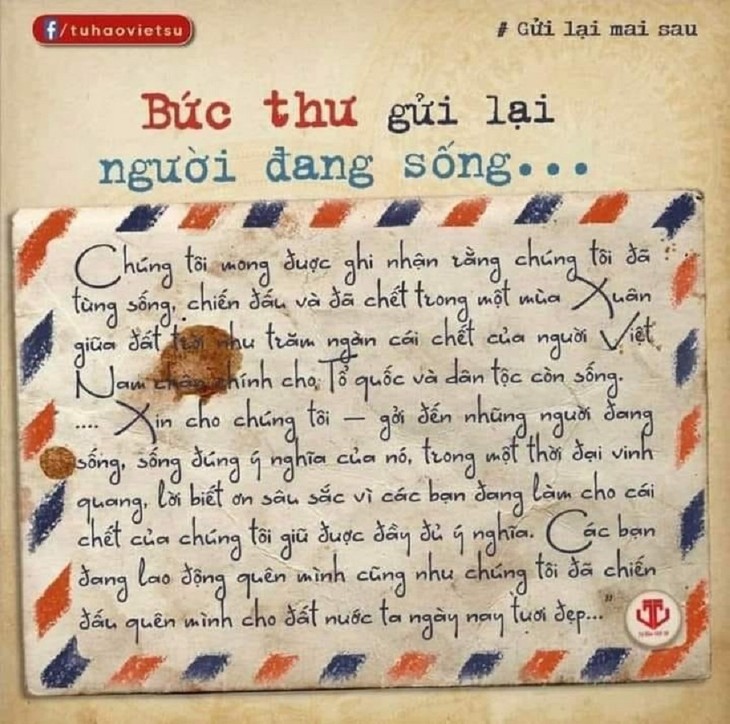 Letter from 3 martyrs: Le Hoang Vu, Nguyen Chi and Tran Viet Dung. (Archived photo) Letter from 3 martyrs: Le Hoang Vu, Nguyen Chi and Tran Viet Dung. (Archived photo) |
Everyone firmly believed in the ultimate victory of the national liberation struggle. Before their deaths in 1966, three soldiers from the Binh Gia Regiment wrote a “Letter to the Living,” expressing their unwavering faith in the nation's eventual triumph and the return of peace. Eighteen years later, in 1984, the letter was found alongside their remains in the upper reaches of the Dong Nai River in Binh Duong province.
The letter reads: “If we were found 5 or 10 years later, when freedom has become true, let us send our deepest thanks to all who live on. Please live your lives to the fullest meaning of freedom in the glorious era to make our deaths meaningful. You’re working dedicatedly with the same selflessness as we fought and sacrificed for our nation, for a beautiful Vietnam, for people living with prosperity and happiness, and for a democratic and just society.”
These soldiers, the survivors and the fallen, have together fostered a combined strength, creating a heroic epic in Vietnam’s history of struggle for liberation and national defense.
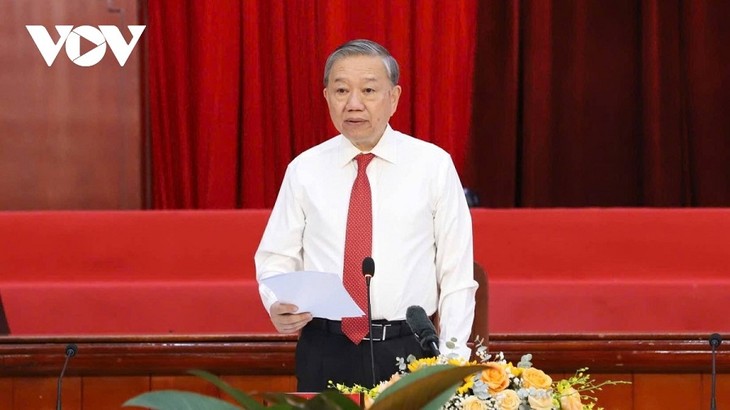 General Secretary To Lam speaks at the meeting with revolutionary veterans and workers to celebrate the 50th anniversary of the Liberation of the South and National Reunification on April 21 in Ho Chi Minh City. (Photo: VOV) General Secretary To Lam speaks at the meeting with revolutionary veterans and workers to celebrate the 50th anniversary of the Liberation of the South and National Reunification on April 21 in Ho Chi Minh City. (Photo: VOV) |
At a meeting on April 21 with revolutionary veterans, national contributors, and policy families in the south, Party General Secretary To Lam said: “No words can fully capture the greatness of the Vietnamese nation, the Vietnamese people, and Uncle Ho's soldiers in the two national resistance wars. No art work can fully express the willpower and tremendous strength of the Vietnamese people and the Vietnamese nation in their aspiration to guarantee 'Vietnam is one, the Vietnamese people are one.' From the flames of wars, the Vietnamese nation emerged victorious, becoming a symbol of conscience and a beacon of life’s purpose for many countries in their struggles for liberation, and a true emblem of the era.”
Vietnam is living in peace and freedom thanks to the great sacrifices of the predecessors, which is a firm foundation for the country to further develop its economy and social progress and become prosperous.
A powerful transformation
As soon as Vietnam achieved national reunification in 1975, a foreign journalist said it would take Vietnam at least 100 years to gain a global standing. But in reality, just 50 years later, Vietnam has shown a powerful transformation in diplomacy, economy, and peaceful development.
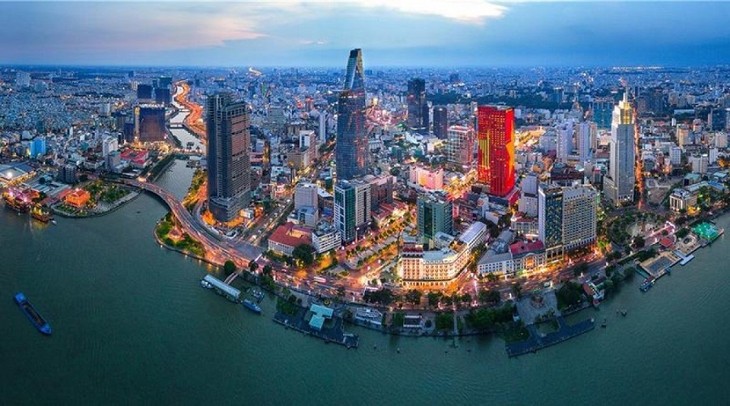 Vietnam is internationally recognized as a “success story” in development. (Photo: VOV) Vietnam is internationally recognized as a “success story” in development. (Photo: VOV) |
French journalist Alain Thomas, who has visited Vietnam many times since the early 2000s, said he is strongly impressed with Vietnam’s drastic transformation.
Thomas said the moment a Vietnamese army tank broke through the gate of the Independence Palace 50 years ago marked the end of decades of foreign domination and the complete victory of a nation that had declared its independence in 1945 under the leadership of President Ho Chi Minh. Thomas said it’s the milestone Vietnamese people began to decide their own political and economic destiny.
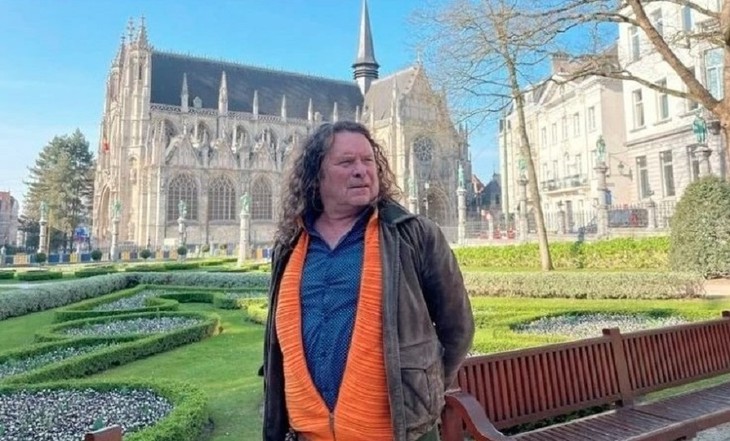 Journalist Alain Thomas (Photo: Huong Giang/VNA) Journalist Alain Thomas (Photo: Huong Giang/VNA) |
Thomas said: “Vietnam is a vivid evidence proving that a small nation can win over seemingly invincible forces. It’s now confidently advancing on the path to becoming a leading Asian economic power.”
Alain Thomas highlighted the rise of the middle class in urban areas, the significantly improved living standards, and the surging domestic consumption, along with a booming real estate market.
He especially praised the Vietnamese tradition of promoting education, saying that the culture of seriousness, diligence, and discipline in learning and working is the key for Vietnam to rise in the era of the global economy and digital society.
He expressed his admiration for Vietnam’s enduring political and social stability over the past 50 years: “There have been neither major upheavals nor deep social conflicts, which are the critical factors for Vietnam to advance confidently to the future, especially in the era of technological evolution and global integration.”
Alain Thomas said the Vietnamese people have defeated foreign powers with their bravery, unity, and resilience. These will continue to be powerful driving force for the country to overcome challenges to move forward its journey of national rise.
The celebration of the 50th anniversary of the liberation of the south highlights the value of independence, freedom, and the importance of maintaining a peaceful environment for national development. Half a century since the liberation of the south, the Vietnam-US relations have become a model of reconciliation and cooperation. The former adversaries have become comprehensive strategic partners.
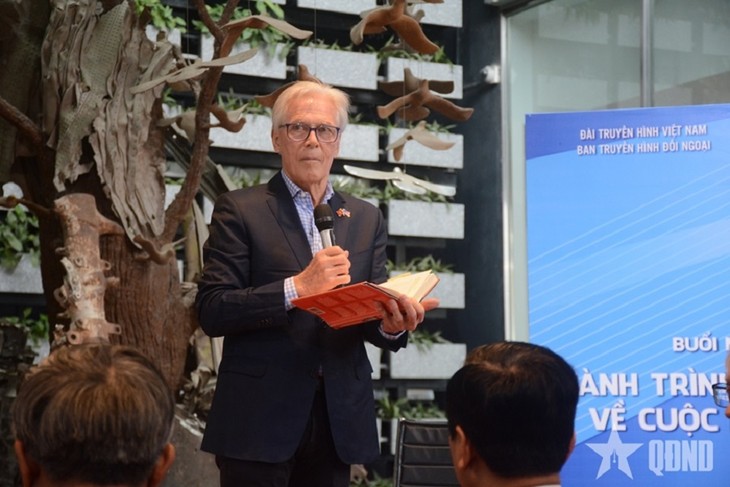 Craig McNamara introduces the book “Because our fathers lied: A memoir of truth and family, from Vietnam to today,” at the Vietnam Military History Museum. (Photo: My Hanh/qdnd.vn) Craig McNamara introduces the book “Because our fathers lied: A memoir of truth and family, from Vietnam to today,” at the Vietnam Military History Museum. (Photo: My Hanh/qdnd.vn) |
In early March, Craig McNamara, the son of former US Secretary of Defense Robert McNamara, who was considered the chief architect of the war in Vietnam, arrived in Vietnam.
Participating in a talk at the Vietnam Military History Museum, which holds hundreds of thousands of artifacts, documents, and other historical materials chronicling the formation, battles, and victories of the Vietnamese army, Craig McNamara wore US and Vietnamese national flag pins side by side on his lapel as a symbol of reconciliation.
Craig McNamara said: “Thank you for taking me on a quick tour, a little mini tour of this remarkable museum. What resonated with me are the missed opportunities. That's what we're here to discuss, that's what we're here to learn, and that's what we're here to make this from. I’m inspired actually by a quick introduction to the remarkable museum.”
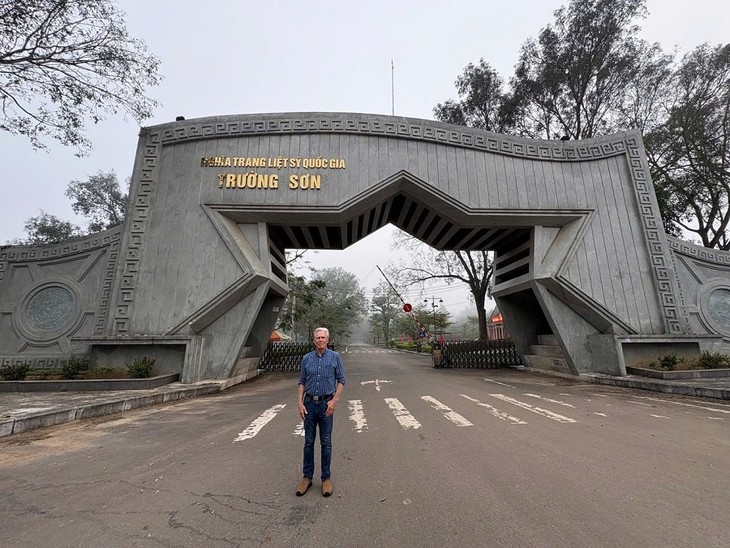 Craig McNamara at the Truong Son National Martyrs’ Cemetery (Quang Tri). (Photo: Courtesy of the character) Craig McNamara at the Truong Son National Martyrs’ Cemetery (Quang Tri). (Photo: Courtesy of the character) |
During his week-long visit to Vietnam, Mr. McNamara visited 6 cities and provinces, and places which associated with his father during the war, including Da Nang beach, the McNamara line, the Ta Con airfield, and the B1 Hong Phuoc base. He also visited the Truong Son National Martyrs' cemetery and Son My village where the My Lai massacre happened.
He met two Vietnamese veterans who participated in the battles in Gia Lai. At the Truong Son cemetery, he burned incense at hundreds of graves and stopped at the tomb of a soldier who died in 1950. Craig McNamara burst into tears because the soldier died on the day McNamara was born.
“It’s General Giap told Robert S. McNamara: you didn't understand our culture, and my greatest regret is that my father did not come to Vietnam to understand your history, your people, your desire to be one nation. All of my adult life, I've lived in the lands of the Vietnam war. And this time, I will go to Vietnam to facilitate a brighter, healthier future for both of our countries,” said Craig McNamara.
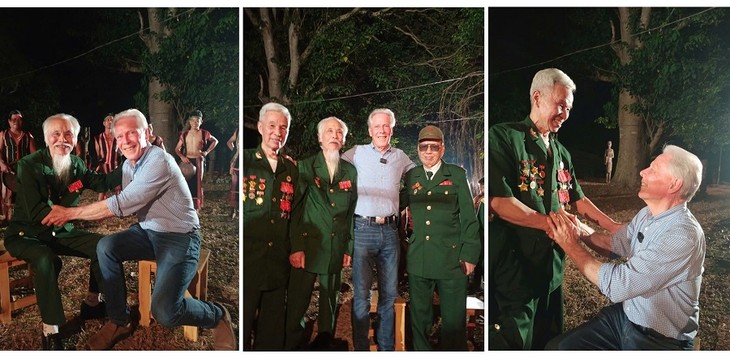 Craig McNamara and Vietnamese veterans (Photo: Courtesy to the character) Craig McNamara and Vietnamese veterans (Photo: Courtesy to the character) |
Craig McNamara said he will dedicate the rest of his life to participating in activities to address legacies of the war, including the effects of Agent Orange/dioxin, the toxic chemical that his father during his eight years as Secretary of Defense had authorized for use in Vietnam.
He also plans to release a Vietnamese edition of his book “Because our fathers lied: A memoir of truth and family, from Vietnam to today,” which recounts his engagement in the anti-war movement, opposing the war that his father was the leading figure in shaping the strategy and carrying out.
April 30, 2025 marks 50 years since Vietnam’s reunification. The April 30, 1975 Victory marked the end of decades of struggling for independence and laid the foundation for Vietnam’s rise on the global stage. Although the path to peace is filled with hardships, the Vietnamese people achieved peace, freedom and happiness and are now united, confidently moving toward an era of national rise to realize new development goals.